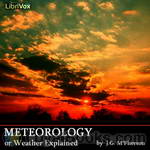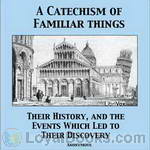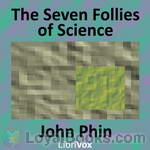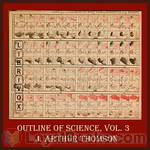|
Books Should Be Free Loyal Books Free Public Domain Audiobooks & eBook Downloads |
|
|
Books Should Be Free Loyal Books Free Public Domain Audiobooks & eBook Downloads |
|
Science |
|---|
|
Book type:
Sort by:
View by:
|
By: John Dutton Wright (1866-1952) | |
|---|---|
 What the Mother of a Deaf Child Ought to Know
What the Mother of a Deaf Child Ought to Know
Wright, a pioneer in the education of the deaf, was a strong advocate for acoustic and auricular training. In this little book, he tries to advise the parents of deaf children and reassure them that there can be a successful and happy life for them. | |
By: J.G. M'Pherson (1845-?) | |
|---|---|
 Meteorology; or Weather Explained
Meteorology; or Weather Explained
Weather Explained: Fog, clouds, rain, haze, thunder, cyclones, dew point and how to count dust motes are just a few of the 35 topics covered in short, easy to read and understand chapters in this book published in 1905. | |
By: Unknown | |
|---|---|
 The Good Housekeeping Marriage Book
The Good Housekeeping Marriage Book
A collection of articles from Good Housekeeping magazine, The Good Housekeeping Marriage Book focuses on the subject of marriage. With instructions and advice from courtship to raising children, this collection aims to assist those with questions and concerns surrounding marriage and the ensuing relationship. Published in 1938. | |
By: Anonymous | |
|---|---|
 A Catechism of Familiar Things; Their History, and the Events Which Led to Their Discovery
A Catechism of Familiar Things; Their History, and the Events Which Led to Their Discovery
This book, a reprint of a successful English publication, has been so enlarged as to be to all intents and purposes new. It has been carefully revised by a Reverend gentleman, who for some time filled the chair of Physics and Chemistry in one of our colleges. Recent inventions and improvements are described in a simple, popular style, so as to be easily understood by all, and short notices are given of prominent inventors and scientists. The paragraphs relating to doctrinal matters conform in every respect to the teachings of the Church... | |
By: Unknown | |
|---|---|
 Prime Numbers
Prime Numbers
A recording of the first 2000 prime numbers (2-17389). Recommended listening for math fanatics and insomniacs! | |
By: Sigmund Freud (1856-1939) | |
|---|---|
 Psychopathology of Everyday Life
Psychopathology of Everyday Life
Professor Freud developed his system of psychoanalysis while studying the so-called borderline cases of mental diseases, such as hysteria and compulsion neurosis. By discarding the old methods of treatment and strictly applying himself to a study of the patient's life he discovered that the hitherto puzzling symptoms had a definite meaning, and that there was nothing arbitrary in any morbid manifestation. Psychoanalysis always showed that they referred to some definite problem or conflict of the person concerned... | |
By: Aristotle (384 BC - 322 BC) | |
|---|---|
 Metaphysics
Metaphysics
Metaphysics is essentially a reconciliation of Plato’s theory of Forms that Aristotle acquired at the Academy in Athens, with the view of the world given by common sense and the observations of the natural sciences. According to Plato, the real nature of things is eternal and unchangeable. However, the world we observe around us is constantly and perpetually changing. Aristotle’s genius was to reconcile these two apparently contradictory views of the world. The result is a synthesis of the naturalism of empirical science, and the mysticism of Plato, that informed the Western intellectual tradition for more than two thousand years... | |
By: Harry Harrison (1925-) | |
|---|---|
 The Misplaced Battleship
The Misplaced Battleship
"It might seem a little careless to lose track of something as big as a battleship ... but interstellar space is on a different scale of magnitude. But a misplaced battleship—in the wrong hands!—can be most dangerous." The world class con man and thief known as the Stainless Steel Rat (diGriz) has another very big problem to solve and this science fiction novella by the great Harry Harrison will see if he can solve it and perhaps four or five more like it before this fascinating and funny tale is finished. 'Use a thief to catch a thief' sounds great but it sometimes has unexpected results. | |
By: H. Beam Piper (1904-1964) | |
|---|---|
 A Slave is A Slave
A Slave is A Slave
The Galactic Empire is slowly 'welcoming' into the family of civilized worlds those systems so far off in the backwater of the galaxy that they have been overlooked and ignored for the past 500 years or so. This is purely routine work because every planet offered the chance has eagerly accepted the invitation. Mainly because the enlightened Empire lets the planetary government continue to rule and do whatever it wants...with a few minor restrictions of course; and because the they are shown what happens to planets who decide not to accept the invitation... | |
By: Herbert J. Hall (1870-1923) | |
|---|---|
 The Untroubled Mind
The Untroubled Mind
A very wise physician has said that “every illness has two parts—what it is, and what the patient thinks about it.” What the patient thinks about it is often more important and more troublesome than the real disease. What the patient thinks of life, what life means to him is also of great importance and may be the bar that shuts out all real health and happiness. The following pages are devoted to certain ideals of life which I would like to give to my patients, the long-time patients who have especially fallen to my lot. | |
By: Harry Harrison (1925 -) | |
|---|---|
 The K-Factor
The K-Factor
The human race has reached the stars, colonized many planets and done amazing things in all areas of scientific progress. But humans are still humans and remain both honorable and not so honorable; some with high ideals and others with very low ones indeed. So why hasn't war occurred in several centuries among the hundreds of planets? Has man really changed? Not on your life it hasn't! Read how science has given man peace but at what cost? | |
By: E.E. Smith (1890-1965) | |
|---|---|
 The Vortex Blaster
The Vortex Blaster
Uncontrolled, terribly violent Atomic Vortices are slowly destroying civilization on every human planet throughout the galaxy. Nothing can contain or stop them despite the lensmen's best efforts until one destroys the home and family of "Storm" Cloud, brilliant atomic physicist. The tragedy triggers actions on his part that pit him one-on-one against the horrible vortices. Introducing "storm" Cloud as THE Vortex Blaster | |
By: Harry Harrison (1925-2012) | |
|---|---|
 The Repairman
The Repairman
This is a collection of 3 of Harry Harrison marvelous early stories that were published in Galaxy, Analog and Fantastic Universe. The Repairman (1958) is a straight fun SF story of a man getting a job done. It is most typical of his later style in series like the Stainless Steel Rat; Toy Shop (1962), a short piece exploring bureaucratic blindness and one ingenious way around it and The Velvet Glove (1956), my favorite for its writing style, fun perspective, sly social commentary on the scene in 1956 and just plain delightful imagination. And he manages to pack excitement and mystery in at the same time. | |
By: Ray Cummings (1887-1957) | |
|---|---|
 The World Beyond
The World Beyond
Lee Anthony finds himself and two of his friends kidnapped and taken on a strange voyage. | |
By: Aristotle (384-422) | |
|---|---|
 On the Heavens
On the Heavens
On the Heavens (Greek: Περί ουρανού, Latin: De Caelo or De Caelo et Mundo) is Aristotle's chief cosmological treatise. In it Aristotle argues that the Earth is a sphere by pointing to the evidence of lunar eclipses. Aristotle also provides a detailed explanation of his theory of 'gravity' arguing that things which contain 'earth' fall towards the centre of the Universe because 'earth' is naturally attracted to the centre of the Universe. Aristotle argues that if the planet Earth was moved to the location of the Moon then objects which contain 'earth' would not fall towards the centre of the Earth but rather towards the centre of the Universe... | |
By: Randall Garrett (1927-1987) | |
|---|---|
 A Spaceship Named McGuire
A Spaceship Named McGuire
Can a spaceship go crazy? Well, yes it can if it has a brain. And the new MG (magnetogravitic drive) experimental robot space ship does indeed have a 'brain'. Completely bewildered as to why the first six models of their supposedly perfect new ship model, the MG-YR, nicknamed the McGuire, have gone totally bonkers after activation and before they could ever be used, the company has called in the services of Daniel Oak. They suspect sabotage of course. Daniel Oak is the hard boiled private investigator with nerves of steel and a mind of the same substance... | |
By: Aristotle (384 BCE-322 BCE) | |
|---|---|
 On Generation and Corruption
On Generation and Corruption
On Generation and Corruption (Ancient Greek: Περὶ γενέσεως καὶ φθορᾶς, Latin: De Generatione et Corruptione, also known as On Coming to Be and Passing Away) is a treatise by Aristotle. Like many of his texts, it is both scientific and philosophic (although not necessarily scientific in the modern sense). The philosophy, though, is essentially empirical; as in all Aristotle's works, the deductions made about the unexperienced and unobservable are based on observations and real experiences... | |
By: Elisha Gray (1835-1901) | |
|---|---|
 Nature's Miracles Volume II: Energy and Vibration
Nature's Miracles Volume II: Energy and Vibration
Elisha Gray was an American electrical engineer who co-founded the Western Electric Manufacturing Company. Gray is best known for his development of a telephone prototype in 1876 in Highland Park, Illinois and is considered by some writers to be the true inventor of the variable resistance telephone, despite losing out to Alexander Graham Bell for the telephone patent.Nature’s Miracles: Familiar Talks on Science, published in 1900, is a discussion of science and technology for the general public. Volume II is subtitled Energy and Vibration: Energy, Sound, Heat, Light, Explosives. | |
By: H. G. Wells (1866-1946) | |
|---|---|
 Anticipations
Anticipations
Wells considered this book one of his most important, a natural follow-up to such works as his Man of the Year Million and The Time Machine. His goal was to get people to think and act in new ways. The book starts with a look at how humans get along socially and how they carry out their business ventures. It then discusses how these elements influence others, such as politics, the world of work, and education. H. G. tried to make clear how the current social order was disintegrating without preparing another to take its place. He then traced the roots of democracy, which in its present state he saw as unworkable. Instead, he proposed a new republic. He also critiqued modern warfare. | |
By: John Cargill Brough (1834-1872) | |
|---|---|
 The Fairy Tales of Science
The Fairy Tales of Science
This book, written in the mid 19th century and illustrated by Charles H. Bennett, provides an entertaining introduction to topics in science for children. In each chapter, the author uses a popular myth or fairy tale to lay the groundwork for an equally fascinating "fairy tale of science" full of interesting facts and real life examples. | |
By: Various | |
|---|---|
 National Geographic Magazine Vol. 01 No. 1.
National Geographic Magazine Vol. 01 No. 1.
National Geographic Magazine Volume 1 Number 1 published in 1889. Topics of articles are:Announcement by the National Geographic SocietyIntroductory Address by the PresidentGeographic Methods in Geologic InvestigationClassification of Geographic Forms by GenesisThe Great Storm of March 11 to 14, 1888The Great Storm off the Atlantic Coast of the United States, March 11th to 14th, 1888The Survey of the CoastThe Survey and Map of Massachusetts | |
By: Murray Leinster (1896-1975) | |
|---|---|
 The Ambulance Made Two Trips
The Ambulance Made Two Trips
Big Jake Connors is taking over his town through violence, inimidation and bribery but Detective Sergeant Fitzgerald can only grind his teeth in frustration. The gangsters seem to have everything going their way until the day that a little dry cleaning establishment declines their offer of 'protection' and strange things start to happen. Murray Leinster gives us another wonderful product of 'what if' from his limitless imagination to enjoy in this gem of a story. Listen and smile. | |
By: Aristotle (384 BCE-322 BCE) | |
|---|---|
 Parva Naturalia
Parva Naturalia
Parva Naturalia [the "short treatises on nature" (a conventional Latin title first used by Giles of Rome)] is a collection of books by Aristotle, which discuss natural phenomena involving the body and the soul. The books are as follows:I - On Sensation and the SensibleII - On Memory and RecollectionIII - On Sleeping and WakingIV - On DreamsV - On Prophecy in SleepVI - On Longevity and Shortness of LifeVII - On Youth and Old Age, Life and Death VIII - On Respiration | |
By: John Phin (1830-1913) | |
|---|---|
 The Seven Follies of Science
The Seven Follies of Science
The seven follies of science; a popular account of the most famous scientific impossibilities and the attempts which have been made to solve them to which is added a small budget of interesting paradoxes, illusions, and marvels. | |
By: Charles Godfrey Leland (1824-1903) (1824-1903) | |
|---|---|
 The Mystic Will
The Mystic Will
This book presents a method of developing and strengthening the faculties of the mind, through the awakened will, by a simple, scientific process possible to any person of ordinary intelligence | |
By: Gaston Maspero (1846-1916) | |
|---|---|
 Manual of Egyptian Archaeology and Guide to the Study of Antiquities in Egypt
Manual of Egyptian Archaeology and Guide to the Study of Antiquities in Egypt
A handbook of Egyptian archaeology, issued by the British Museum, considered suitable for British tourists travelling to Egypt in the 19th Century. (Introduction by Timothy Ferguson) | |
By: J. Arthur Thomson (1861-1933) | |
|---|---|
 The Outline of Science Vol. 3
The Outline of Science Vol. 3
The Outline of Science was written specifically with the man-on-the-street in mind as the target audience. Covering scientific subjects ranging from astronomy to biology to elementary physics in clear, concise and easily understood prose, this popular science work is largely as relevant today as when first published in 1922.In this third volume (of four), we learn about psychic science, the characteristics and interrelations of living creatures, as well as Botany, Biology, and Chemistry. Some chapters are devoted to the new applied sciences of electricity, telegraphy, and flying. | |
By: David Hilbert (1862-1943) | |
|---|---|
 Mathematical Problems
Mathematical Problems
Lecture delivered before the International Congress of Mathematicians at Paris in 1900 and subsequently published in the Bulletin of the American Mathematical Society Vol. 8 (1902), 479-481. | |
By: Plato (424-348 BC) | |
|---|---|
 Laws
Laws
Νόμοι (Laws) is Plato's final dialogue written after his attempt to advise the tyrant Dionysius II of Syracuse. The dialogue takes place between: an Athenian Stranger (Socrates? A god in human form?); the quiet Lacedaemonian Megillus; and the Cretan Cleinias. The Stranger asks whether humans live to be more effective at waging war or if there is something more important a legislator should seek to achieve. During their pilgrimage Cleinias discloses his role in the establishment of a new colony... | |
By: Grenville A. J. Cole (1859-1924) | |
|---|---|
 Rocks and Their Origins
Rocks and Their Origins
Do you know the difference between sedimentary, igneous and metamorphic rocks? Are you interested in their geologic origin, chemical composition or how each type affects the landscape? Do you know the differences between limestone, granite and marble as building materials? You will find these and lots of other interesting facts about rocks in this second edition of "Rocks and Their Origins" published in 1922. The author, Grenville A. J. Cole, was an English geologist, Professor of Geology in the Royal College of Science for Ireland and an avid cyclist. | |
By: Frederick Czapek (1868-1921) | |
|---|---|
 Chemical Phenomena in Life
Chemical Phenomena in Life
Published in 1911 as part of the "Harper's Library of Living Thought," this volume presents an introduction to the chemistry of cells in the context of plant physiology and gives an interesting overview of the field of biochemistry and related sciences at the time. The author, Frederick Czapek, was a Czech botanist and professor of Plant Physiology at the University of Prague. He is perhaps best known for his two-volume work on Plant Physiology, "Biochemie der Pflanzen" and for Czapek solution agar or Czapek-Dox medium, a culture medium for cultivation of fungus species such as Aspergillus and Penicillium molds. ( | |
By: Maurice Maeterlinck (1862-1949) | |
|---|---|
 The children's Life of the Bee
The children's Life of the Bee
Buzz, buzz, buzz. A fascinating and beautifully written explanation of the life of the honey bee. Is the queen the master of the hive or just a hard working servant? What is the purpose of the drones? Why do bees make honey? Do bees ever sleep? Why do bees swarm? Maeterlinck, who won the Noble Prize for Literature, wrote a more scholarly work called The Life of the Bee but then rewrote it in simpler terms so that children could appreciate what goes in a hive. The book describes in simple language the inner workings of a hive from its beginning with a swarm to the fully functional hive with thousands of workers, drones and a queen busily building, repairing and gathering. | |
By: Margaret Burnham | |
|---|---|
 The Girl Aviators and the Phantom Airship
The Girl Aviators and the Phantom Airship
Teenagers Peggy Prescott and her brother Roy share a love of aviation that they inherited from their late father. Mr. Prescott had always dreamed of building an aeroplane that would be free of the defects of planes already invented. Peggy and Roy manage to build a plane starting with the framework their father had begun. Peggy christens it ‘The Golden Buttefly’ and she and Roy are determined to enter it in a young aviator’s contest for a prize of $5000. The Prescotts need the money desperately to save the home they share with their aunt which is about to be taken from them by the rather nasty banker, Mr... | |
By: Mary Huestis Pengilly | |
|---|---|
 Diary Written in the Provincial Lunatic Asylum
Diary Written in the Provincial Lunatic Asylum
Mary Pengilly was taken to a Lunatic Asylum by her sons where she kept a diary, which this book is taken from. Mary records the harsh conditions and treatments received at the hands of the nurses during her stay. Once Mary is released she takes it upon herself to make the authorities aware of the situation at the Provincial Lunatic Asylum. | |
By: William Ruschenberger (1807-1895) | |
|---|---|
 The Elements of Entomology
The Elements of Entomology
The Elements of Entomology is one of seven in a Series of First Books of Natural History Prepared for the Use of Schools and Colleges. It is a succinct little textbook from 1845 presents an introduction to entomology. The author was a surgeon in the U.S. Navy and president of the Academy of Natural Sciences. | |
By: Anonymous | |
|---|---|
 Young Girl's Diary
Young Girl's Diary
The diary of an upper middle class Austrian girl, this book describes her life between the ages of eleven and fourteen. It's a coming of age story full of angst, boys, and questions. | |
By: Various | |
|---|---|
 National Geographic Magazine Vol. 01 No. 2
National Geographic Magazine Vol. 01 No. 2
National Geographic Magazine Volume 1 Number 2 published in 1889. Topics of articles are:Africa, its Past and Future Reports on:Geography of the LandGeography of the SeaGeography of the AirGeography of Life | |
By: Plato (Πλάτων) (c. 428 BC - c. 347 BC) | |
|---|---|
 Republic (version 2)
Republic (version 2)
The Republic is a Socratic dialogue written by Plato around 380 BC concerning the definition of justice and the order and character of the just city-state and the just man. It is Plato's best-known work and has proven to be one of the most intellectually and historically influential works of philosophy and political theory. In it, Socrates along with various Athenians and foreigners discuss the meaning of justice and examine whether or not the just man is happier than the unjust man by considering a series of different cities coming into existence "in speech", culminating in a city (Kallipolis) ruled by philosopher-kings; and by examining the nature of existing regimes... | |
 Gorgias
Gorgias
This dialogue brings Socrates face to face with the famous sophist Gorgias and his followers. It is a work likely completed around the time of "Republic" and illuminates many of the spiritual ideas of Plato. The spirituality, as Jowett points out in his wonderful introduction, has many ideas akin to Christianity, but is more generous as it reserves damnation only for the tyrants of the world. Some of the truths of Socrates, as presented by Plato, shine forth in this wonderful work on sophistry and other forms of persuasion or cookery. | |
By: John D. Rockefeller (1839-1937) | |
|---|---|
 Random Reminiscences of Men and Events
Random Reminiscences of Men and Events
A good book by the oil revolutionist of the 20th century. As they say "Men should listen to experience" and this book is all about the experience of the second highest taxpayer of the US during the 20's. Though it is not in the book, this is a small poem he wrote:I was early taught to work as well as play,My life has been one long, happy holiday;Full of work and full of play-I dropped the worry on the way- And God was good to me everyday. | |
By: Selina Gaye (1840-1914) | |
|---|---|
 The World's Lumber Room
The World's Lumber Room
If this book were written today, it would be called "The Story of the World's Rubbish".That may not sound a promising subject for a book, but we are taken on a journey all over the world (and beyond) to explain the many varieties of dust and refuse - animal, vegetable and mineral - how it is made both by man and by nature, what happens to it, and why we need it. We find that recycling is nothing new: man has been doing it for centuries, and nature has been doing it for billions of years. As every schoolboy knows, 'matter is neither created nor destroyed', so it stands to reason that every particle of it must be somewhere... | |
By: Robert Goadby (1721-1778) | |
|---|---|
 Surprising Adventures of Bampfylde Moore Carew, King of the Beggars
Surprising Adventures of Bampfylde Moore Carew, King of the Beggars
The Surprising Adventures of Bampfylde Moore Carew recounts the wide-ranging exploits of a real-life rogue – a wily professional mendicant who roams 18th-century England extracting charity from merchants, clergyman, and members of the landed gentry alike, employing in his craft an ingenious variety of deceptions and disguises put on for the purpose. Often he impersonates a shipwreck-surviving seaman and uses his wide knowledge of foreign parts and personages to achieve plausibility. Or he might appear on a doorstep as a destitute woman in widow's weeds, toting borrowed babes to enhance the effect... | |
By: B. G. Jefferis and J. L. Nichols | |
|---|---|
 Searchlights on Health
Searchlights on Health
SEARCHLIGHTS ON HEALTH. THE SCIENCE OF EUGENICSBy PROF. B.G. JEFFERIS, M.D., PH. D. KNOWLEDGE IS SAFETY. 1. The old maxim, that Knowledge is power, is a true one, but there is still a greater truth: KNOWLEDGE IS SAFETY. Safety amid physical ills that beset mankind, and safety amid the moral pitfalls that surround so many young people, is the great crying demand of the age. 2. CRITICISM.--This work, though plain and to some extent startling, is chaste, practical and to the point, and will be a boon and a blessing to thousands who consult its pages... | |
By: Francis M. Walters | |
|---|---|
 Physiology and Hygiene
Physiology and Hygiene
Physiology and Hygiene for Secondary Schoolsby Francis M. Walters, A.M.PREFACE The aim in the preparation of this treatise on the human body has been, first, to set forth in a teachable manner the actual science of physiology; and second, to present the facts of hygiene largely as applied physiology. The view is held that right living consists in the harmonious adjustment of one's habits to the nature and plan of the body, and that the best preparation for such living is a correct understanding of the physical self... | |
By: Various | |
|---|---|
 A Book of Natural History
A Book of Natural History
YOUNG FOLKS' LIBRARYA BOOK OF NATURAL HISTORYTHE WONDER OF LIFE, BY PROFESSOR, T. H. HUXLEY. Every one has seen a cornfield. If you pluck up one of the innumerable wheat plants which are fixed in the soil of the field, about harvest time, you will find that it consists of a stem which ends in a root at one end and an ear at the other, and that blades or leaves are attached to the sides of the stem. The ear contains a multitude of oval grains which are the seeds of the wheat plant. You know that when these seeds are cleared from the husk or bran in which they are enveloped, they are ground into fine powder in mills, and that this powder is the flour of which bread is made... | |
By: Leonardo da Vinci | |
|---|---|
 The Notebooks of Leonardo Da Vinci
The Notebooks of Leonardo Da Vinci
The Notebooks of Leonardo Da VinciPREFACEA singular fatality has ruled the destiny of nearly all the most famous of Leonardo da Vinci's works. Two of the three most important were never completed, obstacles having arisen during his life-time, which obliged him to leave them unfinished; namely the Sforza Monument and the Wall-painting of the Battle of Anghiari, while the third--the picture of the Last Supper at Milan--has suffered irremediable injury from decay and the repeated restorations to which it was recklessly subjected during the XVIIth and XVIIIth centuries... | |
By: Bertha M. Clark | |
|---|---|
 General Science
General Science
GENERAL SCIENCEBY BERTHA M. CLARK, PH.D.PREFACEThis book is not intended to prepare for college entrance examinations; it will not, in fact, prepare for any of the present-day stock examinations in physics, chemistry, or hygiene, but it should prepare the thoughtful reader to meet wisely and actively some of life's important problems, and should enable him to pass muster on the principles and theories underlying scientific, and therefore economic, management, whether in the shop or in the home. We... | |
By: Various | |
|---|---|
 Young Folks' Library
Young Folks' Library
Young Folks' Library, Selections from the Choicest LiteratureTHE MARVELS OF NATURE BY EDWARD S. HOLDEN, M.A., Sc.D. LL.D. The Earth, the Sea, the Sky, and their wonders--these are the themes of this volume. The volume is so small, and the theme so vast! Men have lived on the earth for hundreds of the sands of years; and its wonders have increased, not diminished, with their experience. To our barbarous ancestors of centuries ago, all was mystery--the thunder, the rainbow, the growing corn, the ocean, the stars... | |
By: Robert Burton (1577-1640) | |
|---|---|
 Anatomy of Melancholy Volume 3
Anatomy of Melancholy Volume 3
The Anatomy of Melancholy is a book by Robert Burton, first published in 1621. On its surface, the book is a medical textbook in which Burton applies his large and varied learning in the scholastic manner to the subject of melancholia (which includes what is now termed clinical depression). Though presented as a medical text, The Anatomy of Melancholy is as much a sui generis work of literature as it is a scientific or philosophical text, and Burton addresses far more than his stated subject. In... | |
By: Charles Darwin (1809-1882) | |
|---|---|
 Formation of Vegetable Moulds through the Action of Worms with Observations on their Habits
Formation of Vegetable Moulds through the Action of Worms with Observations on their Habits
Charles Darwin LL.B F.R.S was the discoverer of evolution and argued the role of "natural selection" in directing the evolution of species. Darwin also had an interest in the formation of soils (moulds) that began relatively early in his life, with a paper "On the Formation of Vegetable Moulds" delivered to the Geological Society of London in 1937. Darwin's last book, The Formation of Vegetable Moulds through the Action of Worms with Observations on their Habits, was completed in 1881. | |
By: Hallam Hawksworth (1863-?) | |
|---|---|
 Adventures of a Grain of Dust
Adventures of a Grain of Dust
This charming book for children is full of interesting facts about all sorts of plants, insects, birds and animals and how they all help to enrich the soil for farmers - each in its own special way. Join our narrator, The Grain of Dust on a fascinating journey around the planet to meet them. "I don't want you to think that I'm boasting, but I do believe I'm one of the greatest travellers that ever was; and if anybody, living or dead, has ever gone through with more than I have I'd like to hear about it... | |
By: Richard Swann Lull (1867-1957) | |
|---|---|
 Organic Evolution
Organic Evolution
Organic Evolution is a college textbook that describes the mechanism of biological evolution by natural selection. It then explores the evidences for evolution in various animals, including insects, reptiles, birds and humans, mainly from the science of paleontology. | |
By: Various | |
|---|---|
 National Geographic Magazine Vol. 01 No. 3
National Geographic Magazine Vol. 01 No. 3
National Geographic Magazine Volume 1 Number 3 published in 1889. Topics of articles are: The Rivers and Valleys of Pennsylvania Topographic Models International Literary Contest | |
By: An Anti-Slavery Convention of American Women (1837-1837) | |
|---|---|
 Address to Free Colored Americans
Address to Free Colored Americans
The first Anti-Slavery Convention of American Women met in New York City in May, 1837. Members at the Convention came from all walks of life and included such prominent women as Mary Parker, Lucretia Mott, the Grimke sisters, and Lydia Maria Child. One outcome of this important event was a statement of the organization’s role in the abolitionist movement as expressed in AN ADDRESS TO FREE COLORED AMERICANS, which begins: “The sympathy we feel for our oppressed fellow-citizens who are enslaved... | |
By: Aristotle (384 BC - 322 BC) | |
|---|---|
 Physics
Physics
Physics (Greek: Φυσικὴ ἀκρόασις; Latin: Physica, or Physicae Auscultationes) discusses concepts including: substance, accident, the infinite, causation, motion, time and the Prime Mover. | |
By: Anna Botsford Comstock (1854-1930) | |
|---|---|
 Handbook of Nature-Study, Part 1
Handbook of Nature-Study, Part 1
Handbook of Nature-Study was written by Anna Botsford Comstock during an era of growing societal concern for man's treatment of the natural world. Out of this concern grew the nature study movement which sought to teach science to school children (and others) through direct observation of nature by the students themselves instead of by the study of nature books. The book is written as a guide for teachers instructing their classes in nature study and includes a wealth of information about plants, animals, the earth, and the sky along with suggestions for guiding students in their observations... | |
By: United States House of Representatives | |
|---|---|
 Failure of Initiative: Final Report of the Select Bipartisan Committee to Investigate the Preparation for and Response to Hurricane Katrina
Failure of Initiative: Final Report of the Select Bipartisan Committee to Investigate the Preparation for and Response to Hurricane Katrina
In September 2005, the House of Representatives created the Select Bipartisan Committee to Investigate the Preparation for and Response to Hurricane Katrina. The Committee was charged with conducting "a full and complete investigation and study and to report its findings to the House not later than February 15, 2006, regarding-- (1) the development, coordination, and execution by local, State, and Federal authorities of emergency response plans and other activities in preparation for Hurricane Katrina; and (2) the local, State, and Federal government response to Hurricane Katrina... | |
By: Ed Clark | |
|---|---|
 Constructive Beekeeping
Constructive Beekeeping
The author explores the effects of condensation and evaporation as they relate to the success of a beehive. The results of various experiments and the author's thoughts are given. | |
By: Charles George Harper (1863-1943) | |
|---|---|
 Revolted Woman
Revolted Woman
One man's opinion of woman in 1894. Charles Harper believes in the superiority of the male sex and the subordination of the female. He paints an entire gender with the same brush. He believes all women to be identical in mind (illogical) and body (knock-kneed) and vastly inferior to the male. He presents 'facts' to support his opinions: "Woman's Mission is Submission" "for woman has ever been the immoral sex" "how truly like nature their tongues say 'No,' when their hearts throb 'Yes, yes!'" "She... | |
By: Jean-Henri Fabre (1823-1915) | |
|---|---|
 Secret of Everyday Things
Secret of Everyday Things
The clearness, simpicity, and charm of the great French naturalist's style are nowhere better illustrated than in this work, which in its variety of subject-matter and apt use of entertaining anecdote rivals "The Story-Book of Science," already a favorite with his readers. Such instances of antiquated usage or superseded methods as occur in these chapters of popular science easily win our indulgence because of the literary charm and warm human quality investing all that the author has to say. -- Translator (Introductory Note). | |